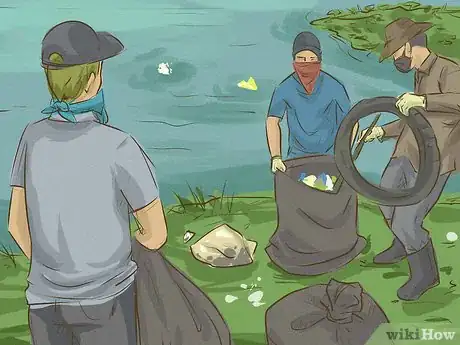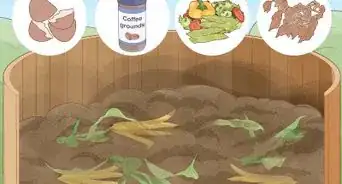wikiHow is a “wiki,” similar to Wikipedia, which means that many of our articles are co-written by multiple authors. To create this article, 11 people, some anonymous, worked to edit and improve it over time.
This article has been viewed 6,929 times.
Learn more...
Have you ever wanted to change the world for the better, but didn't know how? Here's your solution: Start a environments club at your school to keep your school and the local area environmentally friendly. Here is where you'll learn how to have a non- profit environments club that is quite fun, while helping the environment! Read this article to learn how to start an environmental club capable of making substantial environmental change at your school and in your community.
Steps
Starting the Group
-
1Make a preliminary plan for the club. You need to have the basic things covered before you go any further with your idea. You can expand your ideas later on. You can even create a mission statement for your club, as it will serve as a point of direction for members and demonstrate to the local community the goals of the club.
- The key things to consider are who, what, where, why and when.
-
2Decide why you want to start the club. Do you want to have the club to have a theme, like recycling soda cans, or do you just want a club to help the world?Advertisement
-
3Get together a group of like minded students. Do this by asking a few friends who like the environment and if they are interested in joining. Hand out leaflets and posters for the club. They can be very effective and as long as you remember all the key details it could mean that you can get a lot of new members. Ask if you can announce in on your school bulletin. That means that people can be reminded of it every time they look at it.
-
4Approach your head teacher about the idea. Explain your plans for the group and the importance of it. Answer any concerns they might have and find a way around any problems that may occur.
-
5Ask a teacher to supervise and mentor your club. It is vitally important that you have a teacher supervising the group at all times. It is a good idea to get a biology or geography teacher to supervise as they will probably have more knowledge on the it. They also have access to a lot of domains that students do not, such as meeting areas, materials, funding, the ability to create green-based field trips, and more.
-
6Get a meeting place. Somewhere like your room, a clubhouse, an empty classroom or a tree house can be a good idea to host meetings. It may be best to have the meetings in the classroom of the teacher supervising.
-
7Plan the date and time for the group to meet up. Try having a meeting ever week or fortnight. Choose a suitable time to have the meetings lunchtime is good idea.
- Stick to the same date and time every week.
Hosting the first meeting
-
1Do a vote on what should be the name of your Nature Club. Example: The World's Hope Club, Save the Whales Club (for "Save the Whales, you probably need to live near whales.)
-
2Step 9.jpg|center]] Sort out the positions for the club. This includes:
- The club president: leader of the club.
- The club executive(s): A substitute in case a member misses a meeting.
- Green Members & trainees: recyclers-in-training.
-
3Make membership cards or badges. When making the membership cards or badges, put the members name, a picture of them, their number and email address.
-
4If you are able to, Fill the place with and posters books about nature. This makes the place more green and eco-friendly.
-
5Set up a rule chart and set it up where you have meetings. Is your club going to have badges and a sash? Do you want each member to do at least one good thing each week?
-
6If you want to, make a club uniform. When people join, ask them their shirt size, then go out and buy shirts that are the right sizes. They can be any color you want. Green, blue, black, or white would be best, but it's up to YOU.
- Paint a design or your club's logo on the shirts using fabric/craft paint. Return them to your friends.
- Have a club motto to do with recycling. For example reduce reuse recycle.
-
7Make a records book, club diary, or recycling kit. This can be used the schedule meetings, recording new members, and writing down plans. The recycling kit can be used whenever you go on a trip or do volunteer work.
Maintaining the Group
-
1Get a consistent meeting time. Try to arrange meetings at the same time every one or two weeks. If you don't have regular meetings, people are going to forget about it. In the meeting, talk and research nature and the environment, start projects to help the environment, and plan activities and green projects. Find and look at nature but don't do anything harmful talk about nature and just enjoy it.
-
2Be open to new members. Allow new people to join at any time they want. You don't want to put people off joining. Try letting all age groups throughout the school join, older and younger ones.
-
3Start environmental sustainability projects. As a club, everyone should work with members of the school and community to complete sustainability projects that last. Types of projects include:
- Recycling program and Green contest
- Light bulb initiative
- School garden, trail or habitat restoration
- Outdoor classroom construction, or a solar school
- Do a lot of research. Search ideas, news or competitions online based on the theme of the club: the environment. Share anything interesting you find with your group. The more research you do on how we affect the environment, the better the position your club will be in to cultivate sustainability at your school. Remember, knowing is half the battle.
-
4Question whenever your start a new project. What materials will you need to start and finish your green project? How can you raise money for the materials? Who will help you in the community?
-
5Prepare the place you are meeting beforehand. Bring any necessary stuff you need for it beforehand and make sure there is more than enough seats.
-
6Make plans. Decide on ways to help your school become eco friendly. You could start a litter picking committee, plant trees in local areas (with permission), ask the janitor for ideas, get recycling bins, save power on computers or start a gardening area within your school.
- Don't fall into the trap of making empty promises, that can turn out very frustrating, make sure when you promise something, you do it. Plan out your ideas carefully and turn them into action.
-
7Complete your project and start another. Though, you should note that most green projects are never "completed". Most are on going and at a minimum will need monitoring.
-
8Give everyone à pop quiz every once in a while. Use this to test if they remember what they have learned from documentaries and books.
-
9Don’t be afraid to be strict if they keep on not following the rules.
Keeping Intact the Spirit
-
1Occasionally, arrange set up a fun event. These events can be growing your own plants, going to a field trip to a farm, a nature park or a greenhouse, and going to a local park and cleaning up.
-
2Get together on an important environment event. On important days, volunteer on a tree-planting or recycling event. Plant lots of flowers and trees in places. Make sure you must be able to take care of the trees.
-
3Do things to change the world for the better. Recycle cans. Reuse water bottles. Pick up litter. Share the love.
-
4Focus on the goal of the club: to make your school an environmentally friendly place. Gather ideas on how to do it and let everyone's voice be heard. Let everyone share their ideas. Take note of everyone's ideas and make sure to take everyone's ideas seriously.
-
5Take in feedback. Make sure everyone is having a good time there. Ask people what they think of the group and what can be done to improve it.
Warnings
- Be warned, once your environmental club gets its research rolling, it will be tough to select just one project, as schools dramatically impact the environment. However, your club, especially in its first years, should focus on one project at a time.⧼thumbs_response⧽
- Don't try and catch animals and insects because you can get hurt.⧼thumbs_response⧽
- Don`t be a hypocrite, do what you teach.⧼thumbs_response⧽
- Some people may quit the club because it isn't fun, so find some motivators.⧼thumbs_response⧽
- If you go overboard with the activities, your friends may not think it is fun and quit.⧼thumbs_response⧽
Things You'll Need
- some good friends
- nature hut
- membership cards & badges
-Step-1.webp)



-Step-10.webp)

-Step-3.webp)
-Step-9.webp)



-Step-6.webp)
-Step-8.webp)
-Step-11.webp)










-Step-12.webp)



























































